Crops and Ecology
Background
The preservation of fertility is the first duty of all that live by the land … there is only one rule of good husbandry – leave the land far better than you found it.
– George Henderson1
Agriculture is built upon fertile soil, a favorable climate, ample freshwater, a diversity of plant and animal species, and the skills and labor of farmers and farm workers. These are the ecological foundations of our food system. They are also endangered by depletion, disruption, or disease. Finding ways to better preserve the health of agricultural ecosystems is key to the long-term sustainability of our food supply.
Most of the challenges described here relate most directly to crop production, but because crops are grown in large part to feed livestock, the production of meat, milk, and eggs is also heavily implicated. In North America, for example, only 40 percent of cropland is used to feed people directly; most of the remainder is used to grow feed for animals.2
Soil
Land, then, is not merely soil; it is a fountain of energy flowing through a circuit of soils, plants, and animals.
– Aldo Leopold
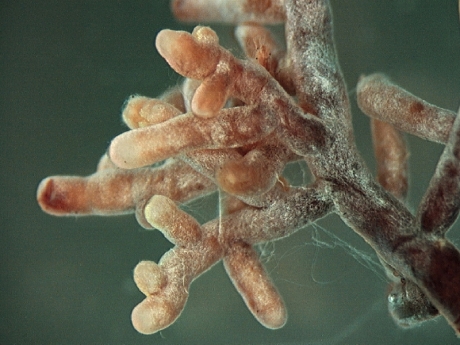
Far from being lifeless dirt, fertile soil is teeming with organisms that have important roles in agriculture. Bacteria living inside the roots of plants in the legume family, such as beans and clover, extract nitrogen (a key nutrient for plants) from the atmosphere. Certain species of fungi that grow on the surfaces of roots (pictured) also help deliver nutrients to plants. Earthworms, meanwhile, help decompose decaying leaves, excrete nutrient-rich castings, and loosen soil by burrowing through it.5
Image source: Nilsson et al., 2005. BMC Bioinformatics, volume 178, issue 6. Creative Commons CC BY 2.0.
Almost everything we eat can be traced back to soil. Far from being lifeless dirt, fertile soil is teeming with organisms, including worms, arthropods, bacteria, fungi, and plant life. The decaying (and fully decayed) remains of these and other organisms, and their excrement, make up the part of soil called organic matter. The remaining mineral fraction of soil is composed of sand, silt, and clay.
Organic matter and the organisms that inhabit it are a large part of what makes soil fertile. Organic matter soaks up water and nutrients like a sponge, helping plant roots to access them. Because soil organic matter helps capture and hold water, it is particularly important during droughts. Organic matter also helps aerate soil, providing roots with oxygen, and it stores carbon that would otherwise contribute to climate change.
Building and maintaining healthy soil require care on the part of farmers. Throughout history, farmers have mismanaged this essential resource, sometimes with catastrophic results. Plowing soil and compacting it (e.g., by driving over it with heavy machinery), for example, can make soil more prone to erosion—the removal of soil by wind, rain, and other forces. Erosion is particularly damaging because the top layer of soil (topsoil) is richest in organic matter. Erosion can also contribute to water pollution by transporting pesticides and excess nutrients into nearby streams and rivers. On much of the world’s agricultural land, fertile soil is still being eroded much faster than it can be restored by natural processes.3,4
Freshwater
We know the value of water when the well runs dry.
– Benjamin Franklin
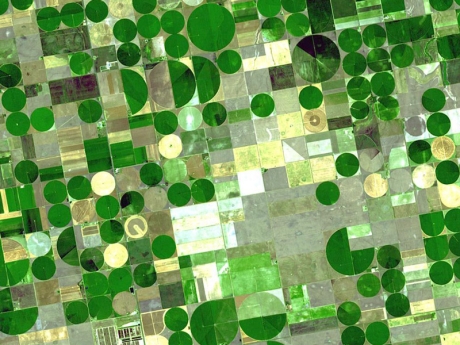
This satellite photo shows irrigated crop circles in Kansas. Each plot is between 800 and 1,600 meters (1 mile) in diameter. In these systems, water is pumped from a well in the center of the circle and distributed through a long sprinkler that pivots around a central point. This area draws water from the Ogallala Aquifer, an underground water body that lies beneath portions of eight U.S. states.
Photo credit: NASA. Public domain.
Growing crops and raising animals for food depend on a reliable supply of freshwater. This resource is surprisingly scarce: of all the water on Earth, only 2.5 percent is freshwater; the rest is salty. The vast majority (99 percent) of freshwater is locked in glaciers, icecaps, or below ground, and is mostly unavailable. The remaining amount—a tiny fraction of all the water on Earth—is responsible for serving most of our water needs.7,8
Where rainfall is inadequate, farmers draw from rivers, lakes, reservoirs, wetlands, and groundwater to supply crop fields with freshwater. An estimated 17 percent of global agricultural lands are irrigated, and crop irrigation accounts for an estimated 90 percent of global freshwater consumption.9
In many parts of the world, freshwater supplies are being depleted much faster than natural processes can restore them. The High Plains Aquifer, for example, is an underground freshwater body that lies beneath portions of eight U.S. states. Parts of the aquifer have already been drained by as much as 30 percent, in large part for corn—a particularly thirsty crop, in high demand for cattle feed and biofuels.10 Many farmers in the area have already reported that their wells no longer supply water, or have become more costly to operate.11 The aquifer could take hundreds if not thousands of years to naturally recharge.
Agrobiodiversity
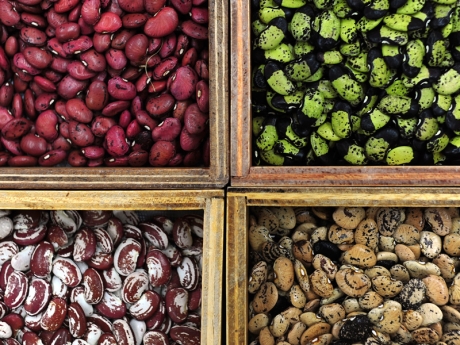
Beans stored at a seed bank in Colombia.
Many useful crop varieties that were developed over centuries are now rarely used in agriculture. Seed banks act as a botanical “Noah’s Ark,” preserving crop varieties to help ensure the world has access to them in the future. Storing these genetic resources can protect them during catastrophic events, such as wars and natural disasters.
Photo credit: Neil Palmer, CIAT, 2011. Creative Commons CC BY 2.0.
Agrobiodiversity is the variety within and among species involved in food and agriculture.
There are roughly 10,000 known edible plant species in the world. From this vast diversity of food sources, only three—rice, maize, and wheat—provide nearly 60 percent of the calories and protein that people derive from plants.12 In the U.S., roughly half of cropland is used for monocultures (large areas planted with a single genetically uniform crop) of corn and soybeans.13 Relying on such a narrow range of agrobiodiversity is like putting all our eggs in one basket—if one variety succumbs to a pest outbreak, or becomes unsuitable for a region’s climate, food supplies suffer a major loss.14
More than just the “spice of life,” diversity helps farmers adapt to changing conditions. Some crop varieties, for example, are better than others at tolerating droughts or resisting certain pests. These and other traits are particularly important in the face of a rapidly changing climate.
Each crop variety also offers unique flavors, textures, and nutritional properties. Many serve medicinal purposes, or have cultural significance to the people who grow and eat them. Over the past century, however, thousands of crop varieties and animal breeds have become rare or extinct.15 Farmers can preserve agrobiodiversity by continuing to cultivate traditional foods.
The countless “wild” organisms that play supporting roles in food production are also an integral part of agrobiodiversity. One coffee plantation in Mexico, for example, is home to as many as 180 different species of birds that help control insect pests and disperse seeds.15 Globally, an estimated 35 percent of the food supply depends on a variety of bees, birds, butterflies, and other pollinators.16 Even among organisms in soil, greater diversity can enhance the beneficial services they offer.5
Pesticide Use
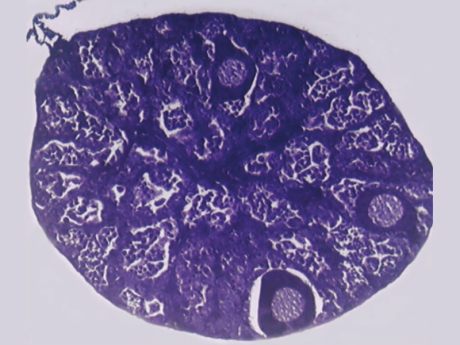
Enlarged cross section of American leopard frog testes. What’s wrong with this picture?
The frogs in this study were exposed to atrazine, one of the most commonly used herbicides in the world. Atrazine has been shown to affect the sexual development of amphibians—the three large circular objects in this image are egg cells—not something one expects to find in male anatomy.
Image source: Tyrone Hayes, Kelly Haston, Mable Tsui, et al., 2002.29
Pesticides are used with the intent of killing a target organism (pest), such as an insect, plant, or fungus that interferes with a food crop. Pesticides often have unintended effects on other, non-target organisms. Some pesticides are non-toxic to humans, while others are highly toxic. Some pesticides persist (do not break down) in the environment, remaining toxic to people and wildlife for many years.
People may be exposed to pesticides by breathing or touching them (e.g., while working on a farm where pesticides are sprayed), drinking contaminated water, or eating produce with pesticide residues. Depending on the pesticide, exposure may increase people’s risk for certain cancers and problems with their reproductive, immune, endocrine, and nervous systems.14
Pesticide use has also been implicated in sex reversals in amphibians;17 weakened immune systems in dolphins, seals, and whales;14 declining populations of beneficial organisms (e.g., pollinators and predators of pests);14,18,19 and other harms to wildlife. Many studies suggest insecticides are contributing to recent and dramatic declines in honey bee populations—a global phenomenon called colony collapse disorder (CCD).20–24 Recent surveys indicate that roughly 30 percent of U.S. honey bee colonies are lost each winter, in part due to CCD.25 Beekeepers can recover some of these losses, but they are still alarmingly high. In the words of one entomologist, “If we lost one in every three cows in the winter… the National Guard would be out.”26
Over time, pests may develop resistance to the chemicals used against them. When this happens, farmers may apply more (or different) pesticides to achieve the desired result,27,28 worsening the potential dangers posed by their use.
Refer to Food Safety for more on pesticides in food.
Farm Worker Health
It's ironic that those who till the soil, cultivate and harvest the fruits, vegetables, and other foods that fill your tables with abundance have nothing left for themselves.
– Cesar Chavez
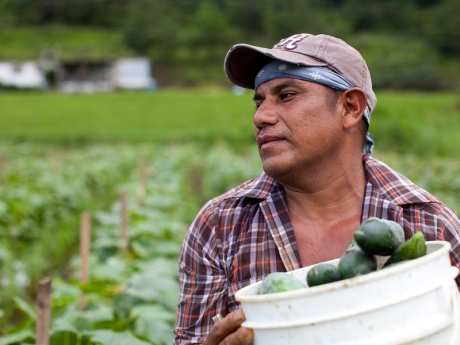
A migrant worker carries cucumbers in Blackwater, Virginia.
"Our very lives are dependent, for sustenance, on the sweat and sacrifice of the campesinos. Children of farm workers should be as proud of their parents' professions as other children are of theirs.” – Cesar Chavez, American farm worker, labor leader, and activist on behalf of migrant workers.
Photo credit: Laura Elizabeth Pohl/Bread for the World, 2011. Creative Commons CC BY-NC 2.0.
U.S. agriculture depends on an estimated 2.5 million hired farm workers. Hired farm workers are distinct from farmers, who manage the farm and are usually self-employed.30 Farm workers are often hired for part of the season to help with labor-intensive tasks such as harvesting, washing, and processing fruits and vegetables.
Despite their crucial roles in the U.S. food supply chain, farm workers are often poorly compensated and subjected to occupational hazards.
Nearly two-thirds of seasonal farm workers involved in crop production live in poverty, half earn less than $7,500 a year, and fewer than one in five has health insurance. Most seasonal farm workers are from Mexico or Central America, and at least half who migrate to the U.S. are undocumented.30 Poverty, lack of insurance, and language barriers may deter them from seeking medical assistance, and fears of deportation may deter them from advocating for safer working conditions.30
U.S. farm workers face particularly high risks of toxic exposure to pesticides, particularly when pesticides drift (are blown by wind) away from where they are sprayed.31 Workers in crop production also suffer 80 percent more injuries compared to the national average for private industries.32 Only one in 10 seasonal farm workers claims the ability to read or speak English fluently, potentially increasing their risks of pesticide exposure and injury (e.g., if they are unable to read warning labels).
See also Industrial Food Animal Production.
Nutrient Pollution
To provide crops with nutrients for growth, farmers often apply fertilizers such as synthetic nitrogen, minerals, animal manure, or human sewage. The use of human and animal excrement as fertilizer is an ancient method of recycling organic matter, transforming waste into food. But when more fertilizer or manure is applied than plants can use, the excess nutrients become “too much of a good thing,” seeping down into groundwater or being carried into nearby waterways by runoff (the flow of water, e.g., rain or irrigation water, over land).
Nutrient pollution in aquatic ecosystems can stimulate algal blooms—rapid accumulations of algae. After the algae die, bacteria feed on the decomposing remains, using up oxygen from the water. This process can create dead zones—underwater regions where oxygen levels are too low for most plants and animals to survive.33 Dead zones have become common in U.S. coastal regions, such as the Chesapeake Bay. Globally, the number of dead zones has roughly doubled every decade since the 1960s.34 A dead zone in the Gulf of Mexico, largely a result of fertilizer and manure runoff from corn and soy fields in the Midwestern United States,, reaches the size of the state of New Jersey at times of the year.34,35
Nutrient pollution can also impact health. Drinking groundwater contaminated with high levels of nitrate (a form of nitrogen, an important crop nutrient) has been linked to reproductive problems, diabetes, thyroid conditions, and blue baby syndrome—a potentially fatal condition among infants.36
In surface waters, nutrient pollution can stimulate the growth of toxin-producing microorganisms. People may be exposed to these toxins by fishing or swimming in contaminated waters, or eating contaminated seafood. Exposure may cause neurological impairments, liver damage, stomach illness, skin lesions, and other health problems.37
See also Industrial Food Animal Production.
Fossil Resources
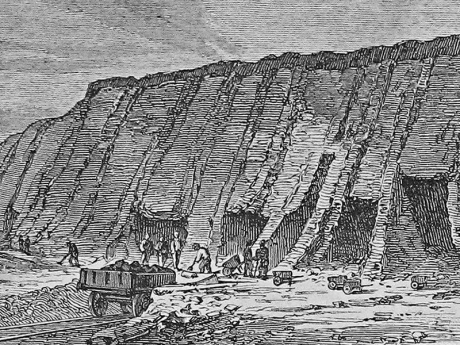
Guano mining operation, Chincha Islands.
The value of phosphorus as an agricultural fertilizer is illustrated by the extraordinary efforts made to obtain it. Deposits of phosphorus-rich bird guano, some up to 200 feet deep, were discovered blanketing islands off the coast of South America. Guano was such a hotly contested commodity that the islands became the epicenter of international conflicts.6
Image credit: Various, 1863. Public domain.
Some resources, such as fertile soil and fresh water, have always been essential to agriculture. Fossil fuels, by contrast, have been widely used in agriculture only since the early 1900s, with the invention of mechanized tractors and synthetic nitrogen fertilizers (manufactured using natural gas). These resources are called “fossil” fuels because they are made from the decayed remains of prehistoric life.
Today, over half of the global energy use for commercial agriculture is attributable to manufacturing synthetic nitrogen fertilizers.38 Fossil fuels are also used in manufacturing pesticides, powering irrigation systems, and transporting goods to and from farms.39
Global oil reserves are estimated to be near or beyond peak oil—the point at which their rate of extraction begins to decline.37 As oil becomes scarce, prices will inevitably rise, leading to higher food prices and more widespread hunger—unless agriculture and other industries swiftly transition to alternative energy sources.39
Phosphorus, a nutrient necessary for plant growth, is present in animal manure and other sources. Like oil, phosphorus can also be obtained from the buried remains of once-living organisms.
The value of phosphorus as an agricultural fertilizer is illustrated by the extraordinary efforts made to obtain it. By the 1800s, England had dug up the phosphorus-rich skeletal remains of countless soldiers from European battlefields, to be ground up and applied to farm fields.6 A German chemist once said of this practice, “Already in her eagerness for bones [England] has turned up the battle-fields of Leipsic, of Waterloo, and of the Crimea… Like a vampire, she hangs from the neck of Europe.”41 Today, commercial sources of phosphorus are obtained by mining phosphate rock—a nonrenewable resource estimated to be depleted in 50 to 100 years.42
Crop Breeding and Genetic Engineering
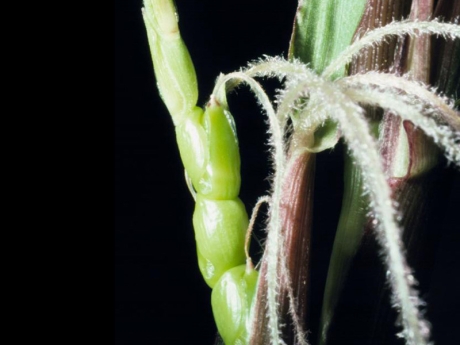
Domesticated crops like broccoli, corn, and tomatoes often appear to have little in common with their wild ancestors. Teosinte (pictured), a wild grass, is thought to be the ancestor of modern maize (corn). Over centuries, farmers and plant breeders have transformed agricultural crops by making them more productive, safer to eat, or better adapted to certain growing conditions.
Photo credit: Matt Lavin, 2009. Creative Commons CC BY-SA 2.0.
Over centuries, farmers and plant breeders have transformed agricultural crops by making them more productive, safer to eat, or better adapted to certain growing conditions. Traditionally, this has been achieved by selectively interbreeding plants to accentuate desirable traits, such as size or sweetness.
Genetic engineering (GE) is a radical departure from traditional breeding methods that use sexual or asexual reproduction. GE takes genetic material from one organism (e.g., a bacterium) and inserts it into another that may be entirely unrelated (e.g., a plant)—a process that does not occur in nature.43
Introduced in 1996, GE crops are now grown on more than 400 million acres—an area roughly the size of Alaska. Nearly two-thirds of GE acreage is in the U.S. and Brazil.44 Most GE crops are engineered either to resist the herbicide Roundup, allowing farmers to spray it without affecting their crops (Roundup is sold by the same company that markets “Roundup Ready” seeds); or to exude a chemical that is toxic to insects using a gene from the bacterium Bacillus thuringiensis (Bt).
After over 20 years of research, thousands of trials, and promises of “feeding the world,” GE’s potential to boost the food supply remains uncertain. Most GE crops have shown little or no increase in yields,45 while the widespread use of Roundup on “Roundup Ready” crops has led numerous weed species to develop a resistance to it.46 According to one survey, nearly half of U.S. farmers reported Roundup-resistant weeds on their farm in 2012.47
While genetically engineered organisms may hold promise, their pervasiveness in agriculture—and our food supply—raises unanswered questions about their potential effects on public health and ecosystems.48,49
Resources
This list is a starting point for further exploration. Some materials may not reflect the views of the Johns Hopkins Center for a Livable Future.
For teachers
- Crops: Growing Problems (lesson plan). FoodSpan. Johns Hopkins Center for a Livable Future.
- The Hands That Feed Us (lesson plan). FoodSpan. Johns Hopkins Center for a Livable Future.
- Introduction to the US Food System: Public Health, Environment, and Equity (textbook). Neff RN (editor). Johns Hopkins Center for a Livable Future. 2014.
Soil
- Losing Ground. Environmental Working Group. 2011.
- Soil erosion and agricultural sustainability (open access). Montgomery D. PNAS. 2007.
- Soil carbon sequestration impacts on global climate change and food security (open access). Lal R. Science. 2004.
- Soil Biology Primer. Ingham ER, Moldenke AR, Edwards CA. USDA Natural Resources Conservation Service. 2000.
Freshwater
- Water Footprint of Food Quiz. GRACE Communications Foundation.
- Water Footprint of Food Guide. GRACE Communications Foundation.
- Online Tools Reveal the Water Footprint of Food. GRACE Communications Foundation.
- Water footprints of nations: Water use by people as a function of their consumption pattern (open access). Hoekstra AY, Chapagain AK. Water Resource Management. 2006.
Agrobiodiversity
- Bee Informed Partnership (website).
- What is it about bees? Three experts on why they’re fascinating, why they’re dying, what can save them (video). Kate Torgovnick May. TED Talks. 2013.
- Importance of pollinators in changing landscapes for world crops (open access). Klein A-M, Vaissière BE, et al. Proceedings of the Royal Society B. 2007.
Pesticide use
- TEDX: The Endocrine Disruption Exchange (website).
- EWG’s Shopper’s Guide to Pesticides in Produce. Environmental Working Group. 2013.
- A Generation in Jeopardy: How pesticides are undermining our children’s health & intelligence. Pesticide Action Network. 2012.
- Insecticide use: Contexts and ecological consequences (open access). Devine GJ, Furlong MJ. Agriculture and Human Values, 2007.
Farm worker health
- A day in the strawberry fields seems like forever. Hector Becerra. Los Angeles Times. 2013.
- Inventory of Farmworker Issues and Protections in the United States. Bon Appétit Management Company and United Farm Workers. 2011.
- Weeding Out Abuses: Recommendations for a law-abiding farm labor system. Farmworker Justice and Oxfam America. 2010.
Nutrient pollution
- Nitrogen in Agricultural Systems: Implications for Conservation Policy. USDA ERS. 2011.
- Spreading dead zones and consequences for marine ecosystems (open access). Diaz RJ, Rosenberg R. Science. 2008.
Fossil resources
- Peak Oil, Food Systems, and Public Health. Neff R, Parker C, et al. American Journal of Public Health. 2011.
- Phosphorus Paradox: Scarcity and Overabundance of a Key Nutrient (open access). Lougheed T. Environmental Health Perspectives. 2011.
- The Story of Phosphorus: Global Food Security and Food for Thought (open access). Cordell D, Drangert J-O, White S. Global Environmental Change. 2009.
Crop breeding and genetic engineering
- Glyphosate-Resistant Weed Problem Extends to More Species, More Farms. Cornucopia Institute. 2013.
- Impacts of Genetically Engineered Crops on Pesticide Use in the U.S. -- the first sixteen years (open access). Benbrook CM. Environmental Sciences Europe. 2012.
- Failure to Yield: Evaluating the Performance of Genetically Engineered Crops. Union of Concerned Scientists. 2009.
References
-
Henderson G. The Farming Ladder. 1944.
-
Foley J a., Ramankutty N, Brauman K a., et al. Solutions for a cultivated planet. Nature. October 2011.
-
Cox C, Hug A, Bruzelius N. Losing Ground. Environmental Working Group; 2011.
-
Montgomery DR. Soil erosion and agricultural sustainability. Proc Natl Acad Sci U S A. 2007;104(33):13268-72.
-
Ingham ER, Moldenke AR, Edwards CA. Soil Biology Primer. Ames, Iowa: USDA NRCS Soil Quality Institute; 1999.
-
Montgomery D. Dirt: The Erosion of Civilizations. Berkeley and Los Angeles: University of California Press; 2008.
-
USGS. The World’s Water. USGS Water Sci Sch. 2014.
-
Shiklomanov I. World fresh water resources. In: Gleick PH, ed. Water in Crisis: A Guide to the World’s Fresh Water Resources. New York: Oxford University Press; 1993.
-
Wada Y, van Beek LPH, Bierkens MFP. Nonsustainable groundwater sustaining irrigation: A global assessment. Water Resour Res. 2012;48.
-
Steward DR, Bruss PJ, Yang X, Staggenborg SA, Welch SM, Apley MD. Tapping unsustainable groundwater stores for agricultural production in the High Plains Aquifer of Kansas, projections to 2110. Proc Natl Acad Sci U S A. 2013;110(37):E3477-86.
-
Wines M. Wells Dry, Fertile Plains Turn to Dust. New York Times. May 2013.
-
Food and Agriculture Organization of the United Nations. Women – Users, Preservers and Managers of Agrobiodiversity. Rome; 1999.
-
US Environmental Protection Agency. Major crops grown in the United States. 2009.
-
Horrigan L, Walker P, Lawrence RS. How sustainable agriculture can address the environmental and public health harms of industrial agriculture. Environ Health Perspect. 2002;110(5).
-
Thrupp LA. Linking agricultural biodiversity and food security: the valuable role of agrobiodiversity for sustainable agriculture. Int Aff. 2000;76(2):265-81.
-
Klein A-M, Vaissière BE, Cane JH, et al. Importance of pollinators in changing landscapes for world crops. Proc R Soc B. 2007;274:303-313.
-
Hayes TB, Khoury V, Narayan A, et al. Atrazine induces complete feminization and chemical castration in male African clawed frogs (Xenopus laevis). Proc Natl Acad Sci U S A. 2010;107(10):4612-7.
-
Devine GJ, Furlong MJ. Insecticide use: contexts and ecological consequences. Agric Human Values. 2007;24:281-306.
-
Brittain C, Potts SG. The potential impacts of insecticides on the life-history traits of bees and the consequences for pollination. Basic Appl Ecol. 2011;12(4):321-331.
-
Henry M, Béguin M, Requier F, et al. A Common Pesticide Decreases Foraging Success and Survival in Honey Bees. Science (80- ). 2012;336(6079):348-350.
-
Whitehorn PR, O’Connor S, Wackers FL, Goulson D. Neonicotinoid Pesticide Reduces Bumble Bee Colony Growth and Queen Production. Science (80- ). 2012;336(6079):351-352.
-
Chensheng LU, Archol KMW, Allahan RAC. Sub-lethal exposure to neonicotinoids impaired honey bees winterization before proceeding to colony collapse disorder. Bull Insectology. 2014;67(1):125-130.
-
vanEngelsdorp D, Evans JD, Saegerman C, Mullin C, Haubruge E. Colony Collapse Disorder: A Descriptive Study. PLoS One. 2009;4(8).
-
Spivak M, Mader E, Vaughan M, Euliss NH. The Plight of the Bees. Environ Sci Technol. 2011;45:34-38.
-
beeinformed.org. 2014.
-
VanEngelsdorp D. A plea for bees. TED. 2008.
-
Van Den Bosch R. Public health advantages of biological insect controls. Environ Health Perspect. 1976;14:161-163.
-
Kirschenmann FL. Cultivating an Ecological Conscience: Essays from a Farmer Philosopher. Lexington, KY: The University Press of Kentucky; 2010.
-
Hayes T, Haston K, Tsui M, Hoang A, Haeffele C, Vonk A. Atrazine-induced hermaphroditism at 0.1 PPB in American leopard frogs (Rana pipiens): laboratory and field evidence. Environ Health Perspect. 2002;111(4):568-575.
-
Villarejo D. The health of U.S. hired farm workers. Annu Rev Public Health. 2003;24:175-93.
-
Calvert GM, Karnik ÃJ, Mehler L, et al. Acute Pesticide Poisoning Among Agricultural Workers in the United States , 1998 – 2005. Am J Ind Med. 2008;51:883-898.
-
Bureau of Labor Statistics. Injuries, Illnesses, and Fatalities. 2013.
-
Mallin MA, Cahoon LB. Industrialized animal production — a major source of nutrient and microbial pollution to aquatic ecosystems. Popul Environ. 2003;24(5):369-385.
-
Diaz RJ, Rosenberg R. Spreading dead zones and consequences for marine ecosystems. Science (80- ). 2008;321(5891):926-9.
-
Alexander RB, Smith R a, Schwarz GE, Boyer EW, Nolan J V, Brakebill JW. Differences in phosphorus and nitrogen delivery to the Gulf of Mexico from the Mississippi River Basin. Environ Sci Technol. 2008;42(3):822-30.
-
Burkholder J, Libra B, Weyer P, et al. Impacts of waste from concentrated animal feeding operations on water quality. Environ Health Perspect. 2007;115(2):308-12.
-
Van Dolah FM. Marine algal toxins: origins, health effects, and their increased occurrence. Environ Health Perspect. 2000;108(Supplement 1):133.
-
Woods J, Williams A, Hughes JK, Black M, Murphy R. Energy and the food system. Philos Trans R Soc London. 2010;365(1554):2991-3006.
-
Neff RA, Parker CL, Kirschenmann FL, Tinch J, Lawrence RS. Peak oil, food systems, and public health. Am J Public Health. 2011;101(9):1587-97.
-
Frumkin H, Hess J, Vindigni S. Peak petroleum and public health. JAMA. 2007;298(14).
-
Justus von Liebig, quoted in “Theory and Practice In the Use of Fertilizers,” F. Bear (2nd edition, New York, 1938).
-
Cordell D, Drangert J-O, White S. The story of phosphorus: Global food security and food for thought. Glob Environ Chang. 2009;19(2):292-305.
-
Hansen MK. Genetic Engineering Is Not an Extension of Conventional Plant Breeding. 2000.
-
ISAAA. Global Status of Commercialized Biotech/GM Crops: 2013. 2014.
-
Gurian-Sherman D. Failure to Yield. Union of Concerned Scientists; 2009.
-
Benbrook CM. Impacts of genetically engineered crops on pesticide use in the U.S. - the first sixteen years. Environ Sci Eur. 2012;24(1):24.
-
Farm Industry News. Glyphosate-resistant weed problem extends to more species, more farms. 2013.
-
Dona A, Arvanitoyannis IS. Health risks of genetically modified foods. Crit Rev Food Sci Nutr. 2009;49(2):164-75.
-
Pusztai A, Bardocz S, Ewen SWB. Genetically Modified Foods: Potential Human Health Effects. In: Food Safety: Contaminants and Toxins. CAB International; 2003:347-372.
